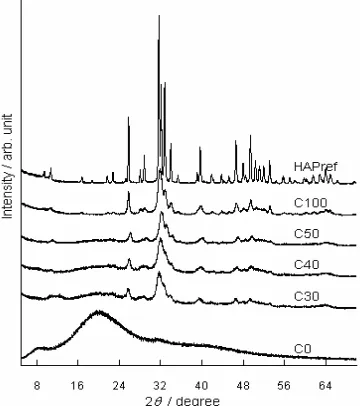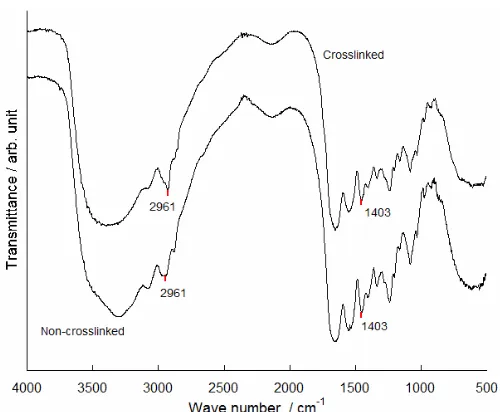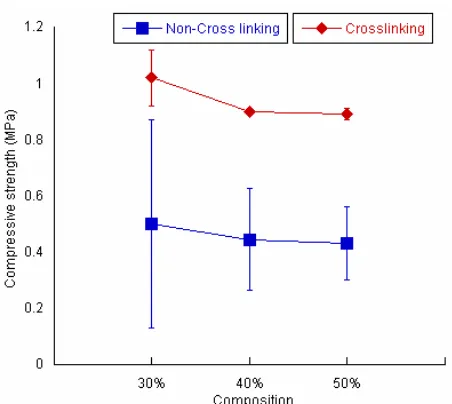EFFECT OF CROSSLINKING TO THE MECHANICAL PROPERTY OF APATITE GELATIN
HYBRID FOR BONE SUBSTITUTION PURPOSES
Sunarso
1, Sutarno
1, Kanji Tsuru
3, Ika Dewi Ana
2,*, and Kunio Ishikawa
3 1Department of Chemistry, Faculty of Mathematics and Natural Sciences, Universitas Gadjah Mada, Sekip Utara, Kotak Pos BLS 21, Yogyakarta 55281, Indonesia
2
Department of Dental Biomedical Sciences, Faculty of Dentistry, Universitas Gadjah Mada, Jalan Denta 1 Sekip Utara, Yogyakarta 55281, Indonesia
3
Department of Biomaterials, Faculty of Dental Science, Kyushu University, 3-1-1 Maidashi, Higashi-ku, Fukuoka 812-8582, Japan
Received May 18, 2011; Accepted November 21, 2011
ABSTRACT
The clinical success of current generation of synthetic bone substitute relies on bio-inspired design which has a performance level close to that of natural one. In this context, biomedical approaches are considered very important to result bio-functional hybrid for bone substitution purposes. In this study, effect of cross-linking to the mechanical properties of apatite gelatin hybrid has been investigated. Cross-linking was employed by 1-ethyl-3-3-dimethylaminopropyl carbodiimide (EDC) agent. The EDC agent creates a peptide bond between gelatin molecules inside the hybrid to the cross-linked structure. Cross-linked structure of gelatin increases physical property of the hybrid since it can hold the outer forces longer than that of without cross-linking.
Keywords:cross-linking, hybrid, carbonated hydroxyapatite, gelatin, physical property
INTRODUCTION
Apatite gelatin hybrid has been widely used for bone substituting purposes since it has similar composition with human bone [1-2]. However, the apatite gelatin hybrid has some drawbacks in term of mechanical properties when the hybrid is applied in real physiological conditions. It is because non-cross-linked collagen-based hybrid materials are rapidly degradedin vivo. Cross-linking is used to control mechanical properties [3] and the durability of the materials by interconnecting the gelatin network chemically.
Cross-linking process results in several biochemical and structural modifications (such as a decreased antigenicity, increased mechanical property, reduced solubility, and a reduced rate of biodegradability) which are desirable in a surgical prosthesis [4-6]. Two types of cross-linking procedures have been developed: physical treatments, such as heat, ultra-violet, and gamma irradiation as well as chemical treatments [7]. In this study, 1-ethyl-3-3-dimethylaminopropyl carbodiimide (EDC) was used to cross-link the apatite gelatin hybrid. The EDC is a zero-length cross-linking type agent which creates a peptide bond between carboxyl and an amine group of gelatin molecules without the introduction of ‘foreign’ molecules in the network [8]. This agent is also known as a
non-toxic and biocompatible cross-linking agent [9]. Therefore, theoretically it is not harmful when implanted into human body.
In order to increase mechanical properties of gelatin, some researchers cross-linked the hybrid by immersing the molded hybrid to the EDC solution [10- 11]. This method will create cross-linked network only in the surface of the hybrid. In view of this, the problem of partial cross-linked network will be solved by modifying the previous cross-linking method with a better method in this research. In the new proposed method done in this research, cross-linking was done by adding EDC solution when the hybrid was still in suspension state to enhance effective cross-linking process of all gelatin molecules.
EXPERIMENTAL SECTION
Materials
Indo. J. Chem., 2011, 11 (3), 267 - 272
268
Table 1. Ratio of apatite to solid content and its preparations
Fig 1. XRD pattern of non-cross-linked apatite gelatin hybrid
Fig 2.XRD pattern of cross-linked apatite gelatin hybrid
Instrumentation
All the specimens were characterized using X-ray Diffraction ([XRD] Rigaku Rint 2000V, Japan). X-Ray
diffraction analysis was made using counter-monochromatic CuKαradiation generated at 40kV and 100mA. Fourier transform infrared spectroscopy ([FT-IR] Spectrum 2000 EX Perkin Elmer) and Scanning Electron Microscopy ([SEM] JEOL JSM-5400LV, Japan) were also used to confirm the XRD results. Compressive strength was used to determine mechanical property of the hybrids and evaluated at a constant crosshead speed of 1mm/min on a universal testing machine (SV-301, Imada, Tokyo, Japan).
Procedure
Apatite gelatin hybrid was prepared by adding Ca(OH)2 to the gelatin solution (gelatin was dissolved to 50 mL of water) for 45 min and 45 °C to make Ca(OH)2-gelatin system in a magnetic stirrer. H3PO4 (dissolved in 50 mL of water) was then dropped wisely to the Ca(OH)2-gelatin system and stirred for 24 h respectively. To crosslink the gelatin molecules, 4 mL of 5%w/v EDC was added to the slurry after it was aged for 24 h, then stirred for 24 h at room temperature. The slurry was then molded into the polymer-mould and put into freezer for 24 h at -17 °C. After freezing, all specimens were freeze-dried for 24 h by freeze-drying machine. The weight ratio of apatite to solid content was varied from 30%, 40%, and 50%w/w with 7.5%w/v solid content (in 100 mL of water). These specimens were then denoted by C30, C40, and C50 respectively. Commercially available hydroxyapatite (HAPref), gelatin (C0), and gelatin-free apatite (C100) were used as control materials.
RESULT AND DISCUSSION
Characterization of apatite gelatin hybrid
All the specimens, both cross-linked and non-cross-linked hybrids, were characterized using XRD, FTIR, and SEM.
XRD analysis
Fig 3. FTIR spectra of non-cross-linked apatite gelatin hybrid
Fig 4. FTIR spectra of cross-linked apatite gelatin hybrid
Fig 5. The FTIR spectra for gelatin and gelatin after cross-linking. Cross-linked gelatin exhibits similar peaks with non-cross-linked gelatin, but it is observed that after EDC treatment, the symmetric stretching of carboxylate salt (1403 cm-1) was decreased in compared to C-H bond (2961 cm-1), indicating that amidation reaction occurred between carboxyl groups and amino groups. These absorption peaks also confirmed that inter and intra-molecular linking occurred to produce cross-linked gelatin network
FTIR analysis
The spectrum of the apatite gelatin hybrid (Fig. 3– 5) gave a combination both typical of apatite [12] and
gelatin [13]. The spectra of hydroxyl ion was detected at 3568 cm-1, while CO3
2-ion at 1455 cm-1 and 1430 cm-1, and PO43-was detected at 1300–900 cm-1 and 570 cm-1 respectively [14]. Amide bands from gelatin were observed at 1500–1700 cm-1[13].
Compressive strength
Compressive strength of the cross-linked hybrid was almost two times higher than that of non-cross-linked hybrid (Fig. 5) in all compositions. Specimen C30 which contained the biggest amount of gelatin showed the highest value of compressive strength than the other compositions. Fig. 6 showed that higher amount of gelatin resulted higher value of compressive strength.
Discussion
In this study, compressive strength measurement was used to determine mechanical property of the hybrids. Apatite gelatin hybrid was prepared as load-bearing bone substitute such as skeletal bone etc. As a load bearing bone substitute, it needs high compressive strength in order to be implanted in human body and to physiologically substitute human bone functions.
Indo. J. Chem., 2011, 11 (3), 267 - 272
270
Fig 6. Compressive strength of both non-cross-linked apatite gelatin hybrid and cross-linked apatite gelatin hybrid
Fig 7. Proposed reaction mechanisms of the amide formation between carboxylic acid and amine in aqueous media in the presence of carbodiimide [15]
of the hybrid. This preliminary data can be used to control not only mechanical property of hybrid but also its degradation rate in the future since cross-linked network of gelatin is known to be insoluble in water [12]. Cross-linking worked only in gelatin molecules so that the larger amount of gelatin in the hybrid, the higher value of compressive strength was observed. Therefore, in Fig. 6, C30 has higher value of compressive strength than both C40 and C50.
Carboxyl groups COOH) and amine groups (-NH2) are functional groups which are being target of EDC to create a peptide bond. The bonding changed gelatin networks to be interconnected each other (Fig. 8). The interconnected networks make the possibility for the hybrid to hold the forces worked to its surface longer than that of non-interconnected networks, yielded high compressive strength values. Reaction mechanism of both carboxyl and amine groups in the presence of EDC in the aqueous media is considered very complicated (Fig. 7) since it might result cross-linked networks by rapid mechanism as well as slow mechanism, hydrolysis, and or N-acrylurea residues.
Gelatin as a protein has variety of functional groups such as –NH2, -OH, and -COOH, which will make the pathway of reaction with carbodiimide very complicated [13]. In the study done by Zeeman et al. [17], EDC known to form intra-molecular cross-links within a gelatin molecule or short-range inter-molecular cross-links between two adjacent gelatin molecules as long as the cross-linked carboxylic acid and amino groups are less than 1.0 nm apart. EDC itself can be hydrolyzed in low pH or in the absence of carboxyl groups [13], producing the corresponding urea derivative which can react with ionized carboxyl group to form product acylisourea. Reprotonation of O-acylisourea will change O-acylisourea to be a carbocation that followed by transferring carbocation in absence of nucleophile to form urea derivative. The ionized carboxyl group is a very strong base, so that the reaction with carbocation may produce carboxylic anhydride in the case of cyclizable carboxyl group, which quickly forms the corresponding amide when amine is present. Therefore, in the case of non-cyclizable carboxyl group, carbocation will react with a water molecule or an unionized amine to yield carboxylate or amide respectively.
Fig 7.Illustration of the effect of cross-linking on a gelatin network structure [16]
is very reactive towards amine groups of (hydroxyl)lysine, producing cross-linking structure product (No. 7, Fig. 7) or making the amount of EDC less than gelatin so that N-acylurea will not be produced during reactions. Therefore, the understanding of cross-linking mechanism and the products by cross-cross-linking reaction are very useful to design cross-linked apatite gelatin hybrid by minimizing the risk when implanted to human body in the future.
CONCLUSION
Cross-linking method which is done during the suspension state of the hybrid fabrication has feasibility to increase mechanical property of apatite gelatin hybrid significantly. In our laboratory now in vitro studies as well as the animal experiments and initial clinical research related to apatite-gelatin hybrids have been being done to understand both physico-chemical and physiological phenomena with regard to the future applications of the hybrids for biomedical purposes.
ACKNOWLEDGEMENT
This research was part of continuing collaboration between UGM and Kyushu University funded by First Batch of JSPS-DGHE. Sunarso was running some parts of the joint works in Kyushu University funded by
Kyushu-University Friendship Scholarship for Undergraduate Students Exchange in 2008 under the supervision of Kunio Ishikawa and Ika Dewi Ana.
REFERENCES
1. Chang, M.C., Ko, C.C., and Douglas, W.H., 2003, Biomaterials, 24, 2853–2862.
2. Landi, E., Valentini, F., and Tampieri, A., 2008, Acta Biomater., 4, 1620–1626.
3. Kikuchi, M., Matsumoto, H.N., Yamada, T., Koyama, Y., Takakuda, K., and Tanaka, J., 2004, Biomaterials, 25, 63–69.
4. Rault, I., Frei, D., Herbage, N., and Hue, A., 1996, J. Mater. Sci. - Mater. Med., 7, 4, 215–222.
5. Sabelman, E.E., 1985, Biocompatibility of Tissue Analogs, ed. D.F. Williams, CRC Press, Boca Raton.
6. Simmons, D.F., and Kearney, J.N., 1993, Biotechnol. Appl. Biochem., 17, 23–29.
7. Weadock, K., Olsen, R.M., and Silver, F.H., 1984, Biomater. Med. Devices Artif. Organs, 11, 4, 293– 318.
8. Young, S., Wong, M., Tabata, Y., and Mikos, A.G., 2005,J. Controlled Release, 109, 256–274.
Indo. J. Chem., 2011, 11 (3), 267 - 272
272
10. Narbat, M.K., Orang, F., Hashtjin, M.S., and Goudarzi, A., 2006,Iran Biomed.J., 10, 4, 215–223. 11. Kim, H.W., Knowles, J.C., and Kim, H.E., 2005, J.
Biomed. Mater. Res.Part B, 74B, 686–698.
12. Krajewski, A., Mazzocchi, M., Buldini, P.L., Ravaglioli, A., Tinti, A., Taddei, P., and Fagnano, C, 2005,J. Mol. Struct., 744-747, 221–228.
13. Chang, M.C., 2008,J. Mater. Sci. - Mater. Med., 19, 3411–3418.
14. Aizawa, M., Ueno, H., Itatani, K., and Okada, I., 2005,J.Eur.Ceram.Soc., 26, 4-5, 501–507.
15. Nakajima, N., and Ikada, Y., 1995, Bioconjugate Chem., 6, 1, 123–130.
16. Kuijpers, A.J., Engbers, G.H.M., Feijen, J., De Smedt, S.C., Meyvis, T.K.L., Demeester, J., Krijgsveld, J., Zaat, S.A.J., and Dankert, J., 1999, Macromolecules, 32, 3325–3333.



![Fig 7. Illustration of the effect of cross-linking on a gelatin network structure [16]](https://thumb-ap.123doks.com/thumbv2/123dok/872246.820874/5.595.161.452.113.391/fig-illustration-effect-cross-linking-gelatin-network-structure.webp)